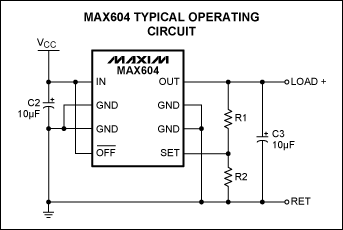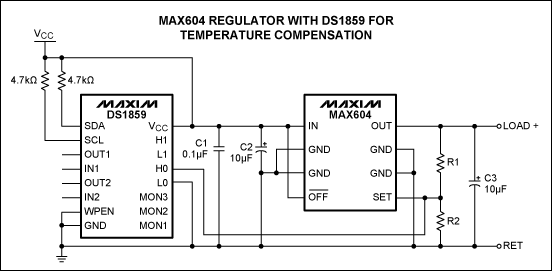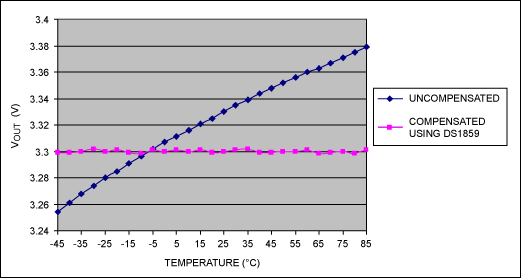

Variable resistor and temperat
电源设计应用
454人已加入
描述
This application note shows how a variable resistor controlled by an integrated, programmable, temperature-indexed lookup table (LUT) is used to offset the temperature drift of regulators. In this application the variable resistor changes value every 2°C based on the LUT. The variable resistor thus effectively nulls any temperature changes (-40°C to +85°C) in a voltage regulator's output, and improves critical system parameters. The DS1859 dual variable resistor serves as the example device.
A similar version of this article appeared in the July 9, 2009 issue of EDN magazine.
This article contrasts the results produced by a voltage regulator in a standard configuration with the results from the same voltage regulator paired with the DS1859 dual, temperature-controlled resistors. The DS1859 compensates for temperature with one of its variable resistors and temperature-controlled lookup tables (LUTs). The DS1859 thus clearly illustrates how a temperature-indexed LUT can improve critical system parameters. Simpler devices, such as the DS1847 dual temperature-controller NV variable resistor, also feature temperature-indexed LUTs and would work just as well. Furthermore, the DS1859 and DS1847 provide closed-loop control without the need for a microcontroller.

Figure 1. MAX604 shown in adjustable output configuration.

Figure 2. Temperature-compensation circuit for MAX604.
These LUTs can be programmed to achieve any R vs. T profile that the user wants. In this example, our goal is to flatten the normal curve of a given regulator over temperature. Consequently, the DS1859's LUTs were programmed so that the digital resistor would have a positive resistance slope with respect to temperature. The resistor has 256 programmable resistance settings (0 to 255 decimal). Each of these steps accounts for ≈ 192Ω. The initial value for the digital resistor was 152 decimal. The value at -40°C was set to 143 decimal, and 158 decimal at +85°C. The values for the digital resistor change every 2°C and were programmed to increment one step for every 4 or 6 degree increase in ambient temperature.
The result of this regulated performance over temperature is a drastic increase in precision. As the data illustrates in Figure 3, a variation of only ±2mV over the temperature range -45°C to +85°C was achieved.

Figure 3. Data plot comparing uncompensated results vs. compensated results.
打开APP阅读更多精彩内容
A similar version of this article appeared in the July 9, 2009 issue of EDN magazine.
Introduction
A regulator provides a continuous, stable voltage to components downstream. Some applications tolerate relatively large supply-voltage swings. Other applications are much more unforgiving of voltage fluctuations; these precision circuits require the voltage regulation to be constant.This article contrasts the results produced by a voltage regulator in a standard configuration with the results from the same voltage regulator paired with the DS1859 dual, temperature-controlled resistors. The DS1859 compensates for temperature with one of its variable resistors and temperature-controlled lookup tables (LUTs). The DS1859 thus clearly illustrates how a temperature-indexed LUT can improve critical system parameters. Simpler devices, such as the DS1847 dual temperature-controller NV variable resistor, also feature temperature-indexed LUTs and would work just as well. Furthermore, the DS1859 and DS1847 provide closed-loop control without the need for a microcontroller.
Uncompensated voltage regulation
A typical regulator circuit consists of the regulating element, a feedback resistor-divider, and capacitors to provide some filtering and load regulation for transient or switching load conditions. The feedback resistor network sets the regulator's output voltage, based on the ratio of the two resistors. In this article, the regulator chosen was the MAX604, which can regulate at a preset 3.3V or any user-adjustable output within its operating range. The MAX604 uses the voltage at the divider to determine its output voltage by feeding the divided voltage into its SET input. As with most regulator circuits, there is a slight variation in output voltage due to temperature. On the MAX604 this variation ranges from 97.6% to 101.5% of the nominal output voltage. Data taken from the circuit shown in Figure 1 verifies this. At -45°C, the output is at 98% of the nominal voltage reading; the output is 101% of nominal at +85°C. These are quite respectable numbers, but let's investigate what can be done to improve these values even more.
Figure 1. MAX604 shown in adjustable output configuration.
Compensation using temperature-indexed LUTs
Figure 2 shows the DS1859 incorporated into the voltage regulator circuit by placing the digital resistor in parallel with R2 in Figure 1. The DS1859's digital resistor is controlled by a temperature-indexed LUT in internal nonvolatile memory. A different resistance value can be programmed for each 2°C window. The 50kΩ version of the DS1859 was chosen for this example.
Figure 2. Temperature-compensation circuit for MAX604.
These LUTs can be programmed to achieve any R vs. T profile that the user wants. In this example, our goal is to flatten the normal curve of a given regulator over temperature. Consequently, the DS1859's LUTs were programmed so that the digital resistor would have a positive resistance slope with respect to temperature. The resistor has 256 programmable resistance settings (0 to 255 decimal). Each of these steps accounts for ≈ 192Ω. The initial value for the digital resistor was 152 decimal. The value at -40°C was set to 143 decimal, and 158 decimal at +85°C. The values for the digital resistor change every 2°C and were programmed to increment one step for every 4 or 6 degree increase in ambient temperature.
The result of this regulated performance over temperature is a drastic increase in precision. As the data illustrates in Figure 3, a variation of only ±2mV over the temperature range -45°C to +85°C was achieved.

Figure 3. Data plot comparing uncompensated results vs. compensated results.
Conclusion
Temperature-indexed LUTs can easily be used to improve system performance over temperature. Because the digital resistors are controlled by individual, independent LUTs stored in nonvolatile memory, each resistor can be tailored to the user's application. Besides the flexibility of the two resistors, the DS1859 also features three ADC inputs for monitoring external voltages.
声明:本文内容及配图由入驻作者撰写或者入驻合作网站授权转载。文章观点仅代表作者本人,不代表电子发烧友网立场。文章及其配图仅供工程师学习之用,如有内容侵权或者其他违规问题,请联系本站处理。
举报投诉
-
non ideal resistor 设置2015-02-11 6261
-
VCA2617,pdf(Dual, Variable Gai2010-09-27 720
-
TMP300,pdf (Resistor-Programma2010-06-01 1106
-
AD604,pdf datasheet (Variable2009-08-26 636
-
One Resistor Takes Heat from S2009-05-07 1190
-
External Resistor Minimizes Di2009-04-28 1622
-
Resistor Color Coder2008-05-09 965
全部0条评论

快来发表一下你的评论吧 !

